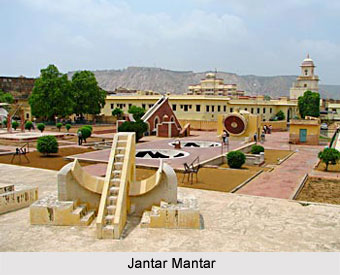 In the city of Jaipur Jantar Mantar is the stone observatory, which is the largest of the world and thus has drawn attention of the tourists from all over the world. Jantar Mantar is built just next to the entry point of City Palace, another place of interest of Jaipur. Maharaja Jai Singh, who founded the city, constructed it. It is one of the 5 astronomical observatories built by him. Jantar Mantar took its shape and configuration at a time between 1727 and 1733. Previously Jantar Mantar was called Yantra Mantra, which signifies instruments and rules. It became Jantar Mantar due to wrong pronunciation of the word.
In the city of Jaipur Jantar Mantar is the stone observatory, which is the largest of the world and thus has drawn attention of the tourists from all over the world. Jantar Mantar is built just next to the entry point of City Palace, another place of interest of Jaipur. Maharaja Jai Singh, who founded the city, constructed it. It is one of the 5 astronomical observatories built by him. Jantar Mantar took its shape and configuration at a time between 1727 and 1733. Previously Jantar Mantar was called Yantra Mantra, which signifies instruments and rules. It became Jantar Mantar due to wrong pronunciation of the word.
History of Jantar Mantar
In the early 18th century Maharaja Sawai Jai Singh II of Jaipur, who from a very young age was attracted by the movement of the celestial objects had constructed five Jantar Mantar in total in New Delhi, Jaipur, Ujjain, Mathura and Varanasi. They were completed between 1724 -1735.
Architecture of Jantar Mantar
Jantar Mantar has a huge collection of instruments of astronomy. They are the unique specimens of architectural wonder. It is a resultant of marvelous effort on the part of ancestors who were keen to know more about astronomy and its several facets. Unique is the fact that Jantar Mantar , Jaipur gives correct information which is easily comparable with that done by contemporary instruments. The way the composite instruments are made taking help of scientific methods bears proof of the strength of Indian Astronomy during medieval period.
Architecture of Jantar Mantar , Jaipur for construction of Jantar Mantar, Jaipur exquisite stones and marbles are used. It has got 14 arithmetical instruments, which could count time, predict eclipses. Also forecasting of several events can be done. Jaiprakash Yantra, Ram Yantra and the Samrat Yantra are the chief astronomical instruments that are built in Jantar Mantar , Jaipur. In the vista of the instruments that are found in Jantar Mantar, Jaipur Sundial deserves special mentioning. It could depict accurate time as far as possible. In the year 1901 this Jantar Mantar, Jaipur has undergone renovation and ultimately in the year 1948 it has gained recognition as a national monument. Presently Jantar Mantar, Jaipur has becomes a landmark in the eyes of the tourists.



















